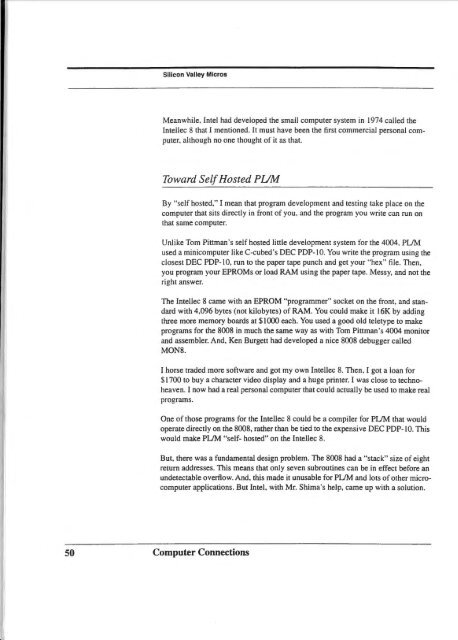appreciate
kildall-p.1-78-publishable-lowres
kildall-p.1-78-publishable-lowres
You also want an ePaper? Increase the reach of your titles
YUMPU automatically turns print PDFs into web optimized ePapers that Google loves.
Silicon Valley Micros<br />
Meanwhile, Intel had developed the small computer system in 1974 called the<br />
Intellec 8 that I mentioned. It must have been the first commercial personal computer,<br />
although no one thought of it as that.<br />
Toward Self Hosted PUM<br />
By "self hosted," I mean that program development and testing take place on the<br />
computer that sits directly in front of you, and the program you write can run on<br />
that same computer.<br />
Unlike Tom Pittman's self hosted little development system for the 4004. PL/M<br />
used a minicomputer like C-cubed's DEC PDP-I 0. You write the program using the<br />
closest DEC PDP-I 0, run to the paper tape punch and get your "hex" file. Then,<br />
you program your EPROMs or load RAM using the paper tape. Messy, and not the<br />
right answer.<br />
The Intellec 8 came with an EPROM "programmer" socket on the front, and standard<br />
with 4,096 bytes (not kilobytes) of RAM. You could make it l 6K by adding<br />
three more memory boards at $1000 each. You used a good old teletype to make<br />
programs for the 8008 in much the same way as with Tom Pittman's 4004 monitor<br />
and assembler. And, Ken Burgett had developed a nice 8008 debugger called<br />
MONS.<br />
I horse traded more software and got my own Intellec 8. Then, I got a loan for<br />
$1700 to buy a character video display and a huge printer. I was close to technoheaven.<br />
I now had a real personal computer that could actually be used to make real<br />
programs.<br />
One of those programs for the Intellec 8 could be a compiler for PL/M that would<br />
operate directly on the 8008, rather than be tied to the expensive DEC PDP-10. This<br />
would make PL/M "self- hosted" on the Intellec 8.<br />
But, there was a fundamental design problem. The 8008 had a "stack" size of eight<br />
return addresses. This means that only seven subroutines can be in effect before an<br />
undetectable overflow. And, this made it unusable for PL/M and lots of other microcomputer<br />
applications. But Intel, with Mr. Shima's help, came up with a solution.<br />
50<br />
Computer Connections


